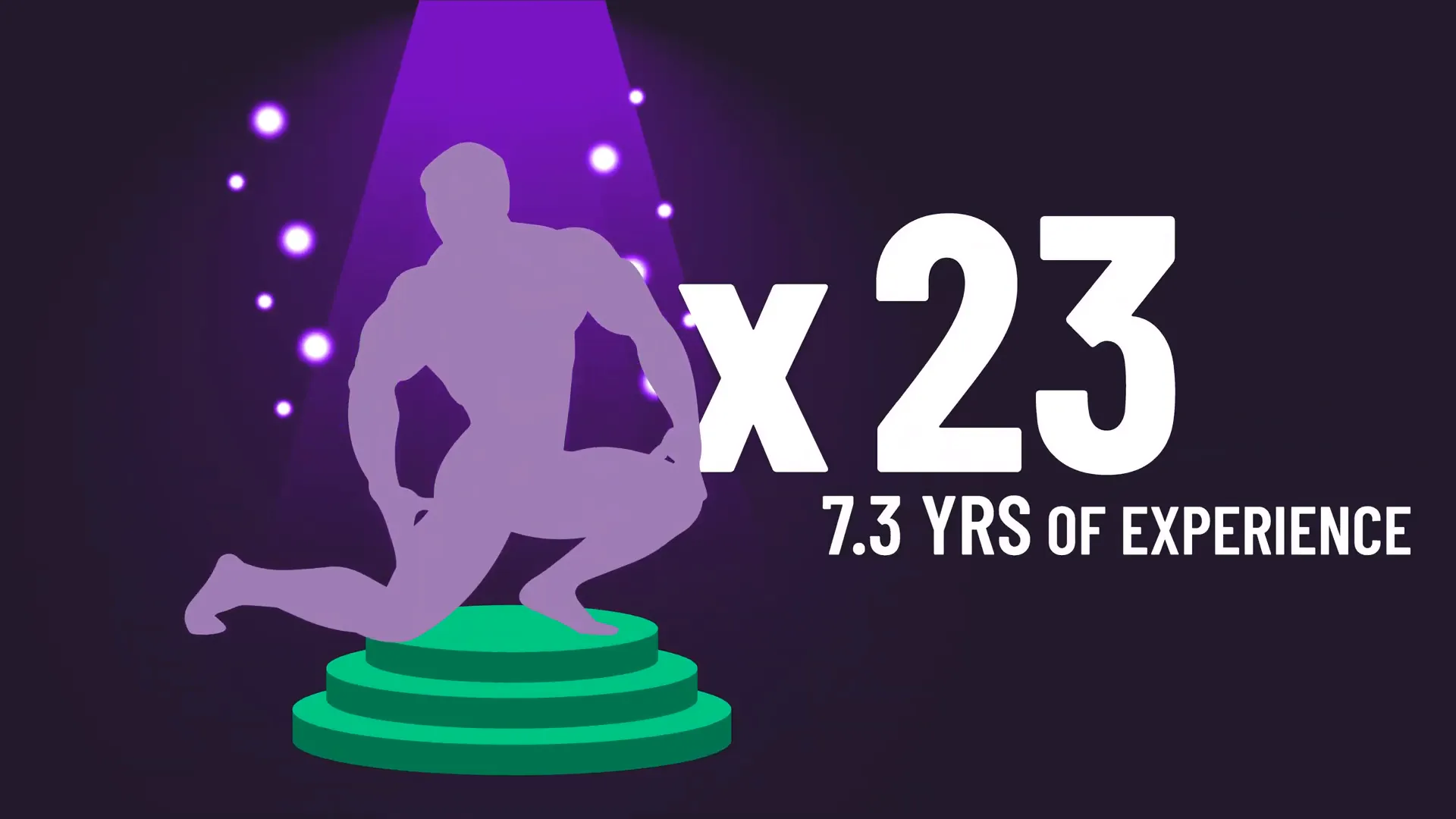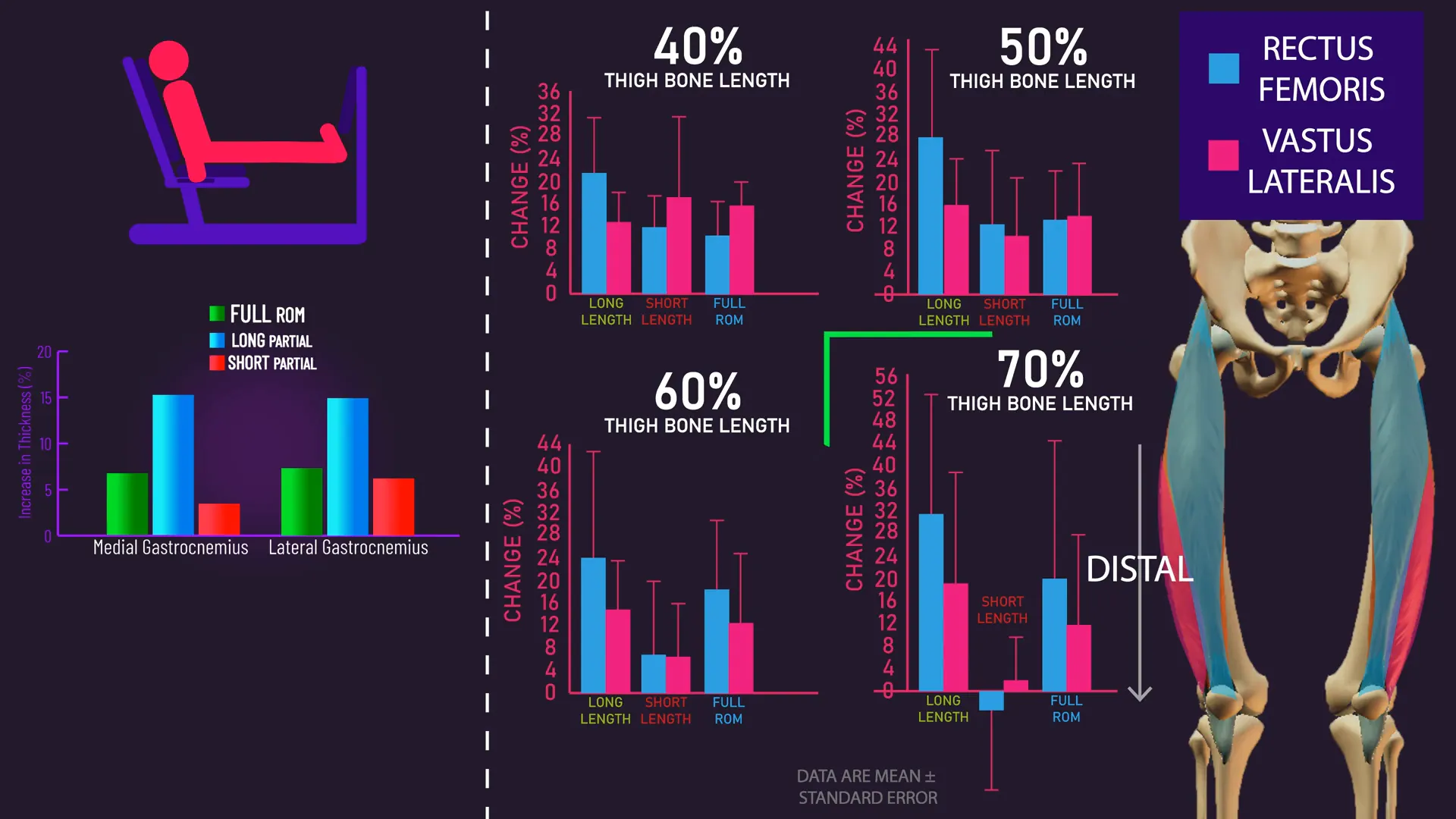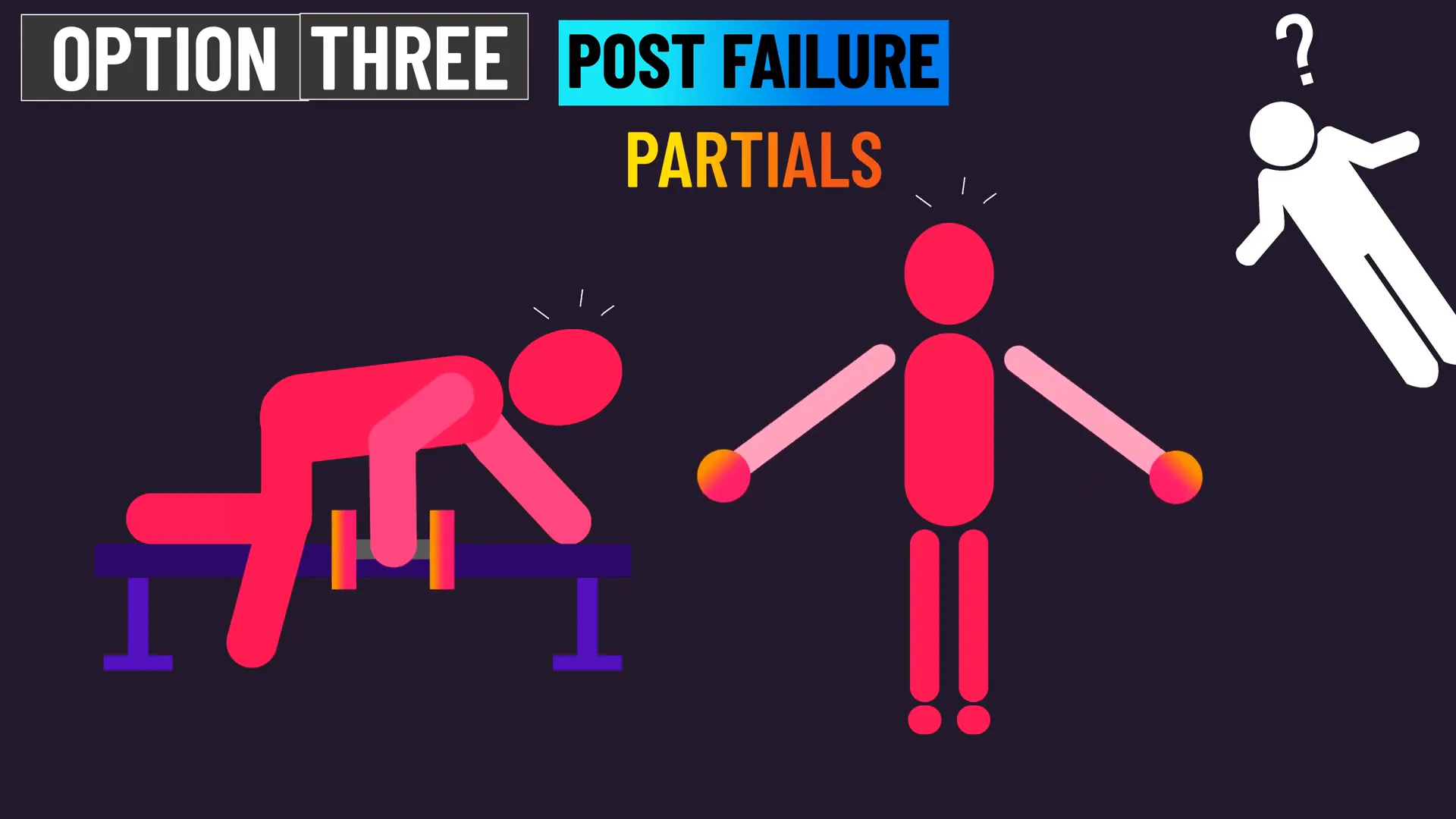Training Beyond Failure for Muscle Growth [New Research]
From failure to growth: Innovative methods for building muscle
![Training Beyond Failure for Muscle Growth [New Research]](/content/images/2025/04/training-beyond-failure-1.png)
Key Takeaways
1. You can boost calf growth by 126.9% with lengthened partials. Hit 10-20 reps in the stretched position—stop when you can’t lift past halfway. More muscle, less guesswork.
2. Your post-failure partials still work—but pick your battles. Trained lifters added 43.3% growth using them. Try 4 sets twice weekly on calves or rows. Improved physique, same effort.
3. Test lengthened partials on quads and hamstrings next. Emerging research suggests they build muscle better than full reps. Track progress. More muscle where it counts, less fat over time.
Want to build more muscle faster? Training beyond failure might be your missing piece.
In this expert review, we analyze, critique, and expand on House of Hypertrophy's breakdown of a pre-print study by Sandberg et al. (2025).
In that study, lifters compared lengthened partials vs. post-failure training for calves. Here, we separate lab results from real-world application—no fluff, just facts.
Why trust this expert review?
- Vetted by experts, including an exercise scientist with 20+ years coaching elite athletes.
- We reveal little-known tips to maximize tension in stubborn muscle groups.
- You get a pro-level calf workout blueprint based on the study’s key insights.
Ready to upgrade your training? Keep reading. We’ll show you how to apply these methods for thicker muscle, leaner legs, and a physique that turns heads.
In a Nutshell: Pushing Past Failure for Growth
Your calves thrive on lengthened partials. Do 4 sets of 10-20 reps twice weekly. Squeeze hard at the bottom. For quads or hamstrings? Try partial leg extensions or stiff-leg deadlifts. Burn the muscle, not your joints.
You build a leaner, stronger physique by mastering tension. Track progress with apps like Alpha Progression. Experiment. Recover. Repeat. The iron doesn’t lie—neither will your gains.
| Key Concept | Main Insight |
|---|---|
| Training beyond failure | Pushes muscles past fatigue, triggers growth. Builds more muscle with smart effort. |
| Shortened position challenges | Exercises like calf raises hit limits. Stop when muscles shorten, miss growth potential. |
| Post-failure partials | Do partial reps after failure. Keeps tension on muscles, adds extra growth stimulus. |
| Lengthened partials | Focus on stretched muscle position. Boosts calf, hamstring growth better than standard lifts. |
| Study findings | 8 weeks of lengthened partials beat post-failure training. Calves grew 3x more. |
| Muscle application | Works best for calves, quads, hamstrings. Skip for chest/back - use full range instead. |
Introduction to Training Beyond Failure
Training beyond failure can be a game changer for your muscle growth. It's about pushing your limits and going the extra mile. When you reach failure, your muscles are taxed. But what if you could push beyond that point? This approach focuses on maximizing muscle tension and stimulating growth. It’s not just about doing more reps; it’s about doing them smarter.
Understanding Shortened Position Challenged Exercises
Some exercises are especially tough at the end of the lifting phase. These are known as shortened position challenged exercises. Think about calf raises or pull-downs. At the top of the movement, the muscle is at its most contracted. Training to failure on these can limit your potential. You fail right when the muscle is at its shortest length.
But there's a way to work around this. Instead of stopping, you can do partial reps. This method effectively targets the muscle at longer lengths. It allows you to squeeze out more work and challenge the muscle further.
What Are Post-Failure Partials?
Post-failure partials are a technique where you continue to perform partial repetitions after reaching failure. After you can’t complete another full rep, you switch to partials. This allows you to keep the muscle under tension. The idea is to target the muscle’s lengthened position, which is often neglected.
Let’s say you’re doing calf raises. You perform full reps until you can’t go any higher. Then, you switch to partial reps, focusing on the lower half of the movement. This can enhance muscle growth by increasing time under tension.
The Effectiveness of Post-Failure Partials
Research suggests that post-failure partials can be effective. In one study, untrained individuals saw greater muscle growth with this method. They trained to failure and then continued with partials. The results indicated that this technique could boost muscle hypertrophy significantly.
However, it’s essential to consider the context. While post-failure partials show promise, they may not always be superior. The effectiveness can depend on how you implement them and the specific muscles you target.
Introducing Lengthened Partials

Lengthened partials are another approach worth exploring. Instead of focusing on the shortened position, you emphasize the lengthened position. This method has shown great potential for muscle growth. It allows you to work the muscle in a way that maximizes tension at a lengthened state.
For instance, during a leg curl, you would perform the movement only through the lengthened portion. This can lead to more significant gains, especially for muscle groups like the calves and hamstrings.
Comparing Lengthened Partials and Post-Failure Partials
So, how do lengthened partials stack up against post-failure partials? The research indicates that lengthened partials may offer better results for certain muscle groups. They allow for increased tension and focus on the muscle's lengthened state, which is often more effective for growth.
While both techniques have their merits, lengthened partials may be the preferred choice for specific exercises. They can lead to better hypertrophy, especially in muscles like the calves. However, it’s crucial to experiment and see what works best for you.
Study Overview: Methodology and Findings

This study focused on trained individuals to assess the effects of lengthened partials versus post-failure partials for calf training. Twenty-three participants, each with an average of 7.3 years of training experience, were recruited. They performed calf raises on a Smith machine, executing four sets twice a week over eight weeks.
Each participant trained one leg with purely lengthened partials, aiming for 10 to 20 reps, stopping when they could no longer lift to 0°. The other leg was subjected to a full range of motion until failure, then continued with partial reps until reaching the same endpoint.
The goal was to match the total number of repetitions across both conditions by adjusting weights appropriately. Medial gastrocnemius thickness was measured to determine muscle growth.
Growth Measurement and Results

The results revealed that muscle growth was generally greater with lengthened partials. Even though the post-failure condition involved reaching failure twice, it did not surpass the growth seen with exclusive lengthened partials. While the study had limitations, including a small sample size and variability in training volumes, the trend was promising.
Statistical analyses showed a lack of strong support for one method over the other, but the preliminary findings suggest lengthened partials may be the better option for calf development.
The Case for Training Calves with Lengthened Partials
Training the calves with lengthened partials appears to be a strategic choice. The evidence hints that this approach generates greater contractile tension at longer muscle lengths, which is crucial for hypertrophy. By avoiding the shortened position, you can maximize muscle tension and growth potential.
Moreover, the research indicates a significant difference in muscle growth percentages. Lengthened partials showed a relative difference of 126.9%, compared to 43.3% for post-failure partials. This suggests that lengthened partials are not only effective but may also offer a more substantial growth stimulus.
Possibilities for Other Exercises and Muscles
Lengthened partials may extend beyond calf training. This concept opens the door for various exercises. For instance, could this method enhance growth for muscle groups like the quads, glutes, or hamstrings? Early studies indicate potential benefits for these areas as well.
One study found that untrained women experienced greater growth in both medial and lateral gastrocnemius muscles using lengthened partials. Another highlighted significant quad growth from leg extensions when using this technique. These findings suggest that lengthened partials might be broadly applicable.
Specific Muscles and Lengthened Partials
While the calf muscles show promise, the effectiveness of lengthened partials may vary by muscle group. The traps and pecs, for example, may not respond as favorably. Many exercises for these muscles challenge them at moderate to lengthened positions already, suggesting that lengthened partials might not be necessary.
However, when it comes to exercises like rows, focusing on the lengthened position may yield better results for traps. The calves, due to their unique force-generating properties, stand out as a prime candidate for this training method.
General Recommendations for Training

Here are several actionable recommendations based on the findings:
- Incorporate Lengthened Partials for Calves: This method appears beneficial, allowing for greater tension and growth.
- Experiment with Lengthened Partials on Other Exercises: While calves are a clear winner, try applying this technique to other muscle groups to gauge effectiveness.
- Maintain a Full Range of Motion: For muscles that respond well to full ranges, stick with traditional methods but consider integrating lengthened partials selectively.
- Monitor Your Progress: Keep track of how your muscles respond to these different training methods to find what works best for you.
Experimenting with Training Techniques

When it comes to pushing your limits, experimenting is key. Training beyond failure isn’t a one-size-fits-all approach. You need to find what resonates with your body. Try different techniques and see how your muscles respond.
Start by incorporating lengthened partials in your routine. Use them on exercises where you feel you can maximize tension. Monitor how your muscles react. Keep track of your progress over several weeks. Adjust based on what you see.
Another option is to blend techniques. For example, you can combine post-failure partials with traditional training. This hybrid approach can provide a unique stimulus. It might unlock new growth potential.
Don’t forget to listen to your body. If you feel fatigued or experience pain, reconsider your approach. Recovery is just as vital as pushing hard. It’s all about finding that balance.
The Beyond Failure Growth Program
Break plateaus. Build dense muscle. This 8-week program uses cutting-edge research on lengthened partials and post-failure techniques. Target stubborn muscles like calves, quads, and hamstrings while burning fat. Science meets sweat.
Overview
- Ideal for: Intermediate lifters with 1+ years training
- Equipment needed: Barbell, dumbbells, cable machine, leg extension/curl station
- Frequency: 4x/week
- Key techniques: Lengthened partials, post-failure partial reps
Program Structure
- Weeks 1-4: Build tension tolerance
- Focus on perfecting partial ranges
- Moderate volume (12-16 sets/muscle group/week)
- Weeks 5-8: Maximize mechanical stress
- Increase load in lengthened positions
- Strategic failure on final sets
Weekly Split
- Upper A (Chest/Back)
- Lower A (Quads/Calves)
- Upper B (Shoulders/Arms)
- Lower B (Hamstrings/Calves)
Workout 1: Upper A (Chest/Back)
- *Lengthened Partials: Perform only the bottom half/stretched portion of the movement (e.g., lower DBs until upper arms are parallel to floor or slightly below for press; focus on the initial stretch and first half of the pull for rows).
- **Post-Failure Partials: Perform full range of motion (ROM) repetitions until momentary muscular failure, then immediately perform the specified number of partial repetitions focusing only on the stretched portion of the movement.
- ***Reps Format: Indicates [Full ROM Reps to Failure] + [Partial Reps].
Pro tips:
- Focus on a deep stretch at the bottom of the Incline DB Press partials.
- Allow shoulder blades to protract fully forward on Cable Row partials for maximum lat stretch.
- Maximize the stretch across the chest during Cable Fly partials.
- Get a full stretch at the bottom (arms extended) on Lat Pulldown partials.
Workout 2: Lower A (Quads/Calves)
- *Lengthened Partials: Perform only the bottom half of the movement.
- **Post-Failure Partials: Perform full ROM repetitions until failure, then immediately perform partial repetitions in the stretched position (bottom of the movement for leg extension).
- ***Reps Format: Indicates [Main Set Reps (Full ROM or to Failure)] + [Partial Reps]. For Calf Raises, perform 15 full ROM reps, then 5 partials from the stretched position.
Pro tips:
- Pause 2s at the very bottom of Smith Machine Squat partials.
- Squeeze calves hard in the fully stretched (bottom) position during the partials.
- Consider using 10% less weight on exercises where you only do partials compared to your full ROM weight for the same reps.
Workout 3: Upper B (Shoulders/Arms)
- *Lengthened Partials: Perform only the bottom portion of the movement (e.g., lower dumbbells to ear level or slightly below).
- **Post-Failure Partials: Perform full ROM reps to failure, then immediately perform partial reps focusing on the stretched portion (e.g., bottom/arms down portion for lateral raise; bottom/arms extended portion for curl).
- ***Reps Format: Indicates [Full ROM Reps to Failure] + [Partial Reps].
- Lengthened Focus: Emphasize the stretch and control the eccentric (lowering) phase, aiming for full ROM but paying special attention to tension in the stretched position.
Pro tips:
- Lead with your pinkies/elbows on lateral raises to emphasize the medial delt.
- Keep elbows relatively fixed in position during Overhead Tricep Extensions to isolate triceps.
- Focus on the stretch at the bottom of the Barbell Curl during the partial reps.
- Aim to add ~5% weight weekly on the main pressing movement (DB Press).
Workout 4: Lower B (Hamstrings/Calves)
- *Lengthened Partials: Perform only the bottom half of the movement, focusing on the stretch in the hamstrings. Maintain a slight bend in the knees and hinge at the hips.
- **Post-Failure Partials: Perform full ROM reps to failure, then immediately perform partial reps focusing on the stretched portion (the start of the curl, when legs are extended).
- ***Reps Format: Indicates [Main Set Reps (Full ROM or to Failure)] + [Partial Reps]. For Calf Raises, perform 15 full ROM reps, then 5 partials from the stretched position.
Pro tips:
- Focus on pushing hips back during RDLs to maximize hamstring stretch; keep the bar close to your shins.
- Ensure a full stretch at the start position (legs extended) on Seated Leg Curl partials.
- Pause for 1-2 seconds in the bottom stretched position on Seated Calf Raise partials.
Notes on Execution
- Track your partial rep counts weekly; aim to increase them or the full ROM reps.
- Aim to add 1-2 reps per set over the weeks or increase weight when hitting the top end of the rep range.
- Use a controlled tempo, especially on lengthened partials: aim for a 3-second eccentric (lowering/stretch phase), 0-1 second pause at the bottom, and a 1-second concentric (lifting phase) (3-0-1 or 3-1-1).
- If you experience joint discomfort, slightly reduce the range of motion on the partials (e.g., by 10-20%) until comfortable.
- Support muscle growth with adequate nutrition: Aim for approximately 1 gram of protein per pound of bodyweight (or 2.2g per kg) daily.
- Stay well-hydrated.
This program turns research into results. Lengthened partials create constant tension. Post-failure sets shock muscles into growth. Expect tighter waistlines and fuller muscles by Week 6.
Want to automate that workout and more? Put your progress on autopilot with Dr. Muscle AI. Our algorithm adjusts weights, tracks partials, and prevents plateaus - so you can focus on lifting. Try it free for 14 days. More muscle. Less guesswork.
Expert Corner: Pro Tips for Faster Gains
Practical Application
- Use lengthened partials for calves. Do 3 sets of 10-20 reps. Focus on the bottom half of calf raises. Keeps tension high. Builds muscle faster.
- Try partials on leg press or leg extensions. After hitting failure, do 3-4 extra partial reps. Boosts time under tension. Burns more fat.
- Track your weights and reps weekly. If you hit 20 reps easily, add 5-10 lbs. Forces growth. Keeps progress steady.
- Test on rows or leg curls. Use partials at the stretched position. 3 sets of 12-15 reps. Improves muscle definition.
Example
- Calf raises: 3 sets of 15 reps. Use partials at the bottom. Add 5 lbs once you hit 20 reps.
- Leg press: 3 sets of 12 reps. After full reps, do 4 partials at the bottom. Cuts fat, builds quads.
Fact-check of Key Points
Claim: Lengthened partials beat post-failure partials for calf growth.
Reality: True in this study, but note the small sample size. Results showed trends, not slam-dunk proof. Individual responses vary. Always track your own progress.
Claim: Lengthened partials work best for calves due to tension at long lengths.
Reality: Plausible, but the study didn’t measure tension directly. Practical experience supports prioritizing stretched positions for stubborn calves. Try it, but don’t abandon full ROM yet.
Claim: Traps/pecs don’t benefit from lengthened partials.
Reality: Unproven. The study tested calves only. Some lifters report growth using partials on incline presses or rack pulls. Experiment cautiously.
Claim: Post-failure partials “significantly boost hypertrophy.”
Reality: Overstated. The study’s untrained subjects saw benefits, but trained lifters may need heavier stimuli. Use sparingly to avoid junk volume.
Key Takeaway: Lengthened partials show promise for calves and possibly quads. But no magic bullet. Pair with progressive overload and smart recovery for real gains. More muscle comes from consistency, not just flashy techniques.
More Little-Known Tips for Faster Growth
Crush sticking points with iso-holds. Hit a rep where you normally stall? Pause there. Hold 2-3 seconds. Fight to push through. This builds brutal strength in weak ranges. More muscle where you need it most.
Steal density from your rest periods. Cut rest by 10 seconds each week. Keep weights heavy. Forces body to adapt faster. Burns extra calories. Shreds fat while preserving muscle.
Turn warm-ups into growth opportunities. Add 3 explosive reps with 50% weight after your warm-up sets. Primes nervous system. Boosts power on working sets. Sneaks in extra volume.
My Take: Why Lengthened Partials Beat Chasing Failure
I’ll pick targeted tension over mindless burnout every time. The Sandberg study nails it – lengthened partials built 126.9% more calf growth than post-failure work, even when reps matched. That’s not a small difference. It tells me chasing failure with partials after collapse doesn’t beat smart tension at long muscle lengths.
Some coaches swear you need to grind through failure for maximum growth. I get it – the burn feels productive. But look at the data. These trained lifters got nearly triple the growth from controlled partials in the stretched position. Your calves aren’t failing because you’re weak; they’re failing because the muscle can’t generate force when shortened. Why waste energy on junk volume when you can hammer the range that matters?
Critics argue post-failure training works for other muscles. Maybe – but calves are different. They’re stubborn, fatigue-resistant, and respond to sustained tension. The study used a Smith machine for precise overload in the stretched position. That’s how you build meaty calves, not by flopping around after failure. Save the burnout for muscles that actually benefit from metabolic stress.
Here’s the kicker: more muscle with less fatigue. Lengthened partials let you push hard without frying your CNS. You recover faster, train more frequently, and keep body fat in check by avoiding excessive volume. That’s how you build a balanced physique that performs as good as it looks. Give me intelligent tension over mindless reps any day.
Stuck in a Muscle-Building Rut? Here’s Your Fix
Most lifters grind through endless sets, thinking more is better. But here’s the truth: your muscles don’t care how much many times you lift. They care how much you push them. The more you pull them under tension, the stronger they grow. Yet most people stop short of the sweet spot—leaving gains on the table.
Want to make it easy? Let the Dr. Muscle app do the heavy lifting. It automates your training, tracks progress, and adjusts your plan like a pro. Try it free and watch your body transform.
FAQ
What is training beyond failure?
Training beyond failure involves pushing your muscles past their point of fatigue. This can include techniques like partial reps or lengthened partials. The goal is to maximize muscle tension and stimulate growth.
How do I know if I should train beyond failure?
If you’re looking to enhance your muscle growth and have a solid foundation, experimenting with these techniques can be beneficial. However, ensure you're also focusing on recovery and listening to your body.
Are there risks associated with training beyond failure?
Yes, there are risks. Overtraining and injury can occur if you push too hard without adequate recovery. It’s essential to balance intensity with rest.
Can beginners use these techniques?
While beginners should focus on mastering techniques first, they can gradually incorporate partials as they become more comfortable. Start slowly and build up intensity over time.
How often should I incorporate these techniques?
It depends on your training goals and recovery ability. You might try them once a week for certain muscle groups and adjust based on how your body responds.

